HiFiMAN HM-801: big sound in your pocket
Start
Jude Mansilla, Founder of the Head-Fi Forum, 05/12/2009.
In our trade and sponsorship community, Mr. Fung, Head of Head-Direct, (or HiFiMAN) was one of the most interesting personalities for me. We met him a long time ago, when several years ago he offered me a sponsorship offer and was actively interested in our affairs, tried to cooperate with me and asked how well he could fit into the movement of our community with his high-end Chinese-made players and headphones. I immediately thought that the guy was crazy, given that I had never heard of this man and his company, even without looking at the country of the manufacturer. I do not know what others would have done in my place, but maybe I made a mistake and it was worthwhile to work with him immediately.
The first headphones that released Head-Direct were Yuin PK-1, and even then the oldest of our community knew that it was from this model that the company showed its supernatural abilities, not even knowing about them. Years passed, and Yuin PK-1 are currently the only headphones with a standard form factor that I (and many other music lovers) use regularly, as they sound very good if there is a portable amplifier available.
')
In the same lineup with the PK series, the OK series was on, this is another product that I initially overlooked. They isolated from the noise a bit unusual, passing some frequencies of the surrounding world into their ears. One of my friends told me that he wanted some in-ear headphones that would keep the sound peculiar to them, would not fall down from his ears, and most importantly could give him the opportunity to work in the office, communicating with colleagues. You should have seen his joy when I brought the little-known Yuin OK-1 on trial.
Of course, Fang brought a lot of different products to us, even a whole line of full-size electrostatic headphones, portable amplifiers and many other devices. Head-Direct leader went a long way before we started working together. For all the time, I learned that Fang never sits still, when it comes to sound quality in the idea of a project, it seems to me that he never sits still.
Fang was very proud to work with us, being the only representative from China, he was proud of his people. One day he sent me a large package, inside of which was a collection of plush toys from a cartoon about the Olympic Games in China. When I asked him about why he did this, he answered simply that he was very excited and proud that China was going to host the Olympiad, and would like to share this spirit with me. I still look at these little toys from time to time and do not hold back my smile. So, Fang's pride helped me make sure that similar Chinese products deserve respect. Later, I realized that in addition to respect, products can be unique, innovative and high-performance.
It was in the spring, Fang contacted me to talk about a new product, which is now working hard: a high-end portable digital player. What was he going to offer, I thought? His answer shocked me. He swore that my iPad with lossless is nothing, that everything is nothing compared to what his team is working on right now. Fang continued to say quickly that he is now developing a portable music player with removable media, with its user interface, with a 15-volt lithium-polymer battery in order to embed a high-quality headphone amplifier module and to allow the user to connect an amplifier using the player also as a sound card. Well, sort of cool, also fantastic, I said. He continued that his main goal was to have a better sound device in the player for converting a digital code into an analog signal (DAC), this is the most important operation in obtaining high-quality sound with minimal losses. At first I smiled, then asked what he would do for this? To which he clearly replied that he planned to install a PCM1704 DAC, in conjunction with an OPA627 operational amplifier. I said that they are crazy, in the sense that it is cool and no one has ever done this before (for those who do not know, PCM1704 and OPA627 were previously used as honorary rights only in high-end audio systems, but never in portable technology ).
Initially, Fang wanted to enable only a coaxial input for the external DAC, but I strongly suggested to enable the USB port in view of the rapidly growing popularity of computers. I said that it would be a shame if the device had PCM1704 , but it would not be possible to upload USB recordings to the player. A few days later, Fang called back and supported my idea, but I said that I would be the first in line to buy this device. Having told me the cost, he asked a question about what I think about the price of the device. I replied that this will find its niche in the market and everything will work out. Fang was very happy and said that he wanted to sell the player with my informational support, as well as previous projects, from which we will receive 10% of sales for a limited time. This is how HiFiMAN HM-801 was born.
A few months later, Fang called and called me to test the prototype of the future player. It just had a firmware with a raw media player and a PCM1704 board without a headphone amplifier module. He wanted me to rate the player as autonomous, play with sound sources, and compare it with other models. That's what I did for a few weeks.
What did I think about this prototype? The very first thing that caught my eye - this is a huge case. We made compromises and made an analog line input through a mini-jack, and an analog coaxial through a mono mini-jack, reducing its size. I showed the guys from the Moon Audio player and arranged with them to create cables to it. In the end, we decided to use a coaxial cable i2Digital X-60 , which showed itself very well. At the theoretical level, this could continue to improve, but we decided not to waste time on it. For analog output, Cardas stereo-mini-RCA was used . From the point of view of cables and performance, it seemed that the HM-801 is the best among portable players today.
In the first full-fledged version, which I managed to listen to, I characterized the sound in two epithets: great and great. No need to even try to say that such a sound is different for portable devices - it would also sound great, being considered desktop studio equipment. I can only single out the main thing: there is nothing better in a large army of portable players whose sound characteristics are better than what I was listening to. Very noticeable similarities with my CD player from Wadia , and for my ears the sound is almost identical, but with a different tinge, which does not prevent me from enjoying the sound from HiFiMAN .
From the creators
Fang, the creator of the player, 12.05.2009.
With the development of high-speed Internet users are increasingly downloading music without compression, with a high level of quality. Unfortunately, most portable players can not show even a smaller part of the potential, which is incorporated in the audio. The HiFiMAN HM-801 player is designed to play high-quality, lossless audio tracks, conforming to the Hi-Fi standard.
With two high-quality DACs, the player wins in the sound of most desktop CD players. Even compared to some high-end non-portable sources, the player behaves best at mid frequencies, which is clearly seen in the frequency range, where vocals and violin manifest themselves.
Overview
Tronz, Head-Fi Review, 12/31/2012.
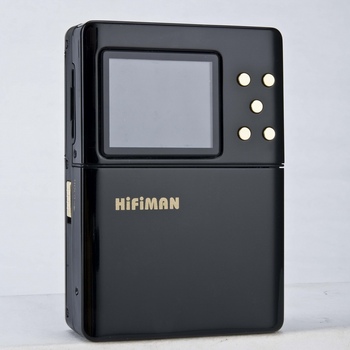
User interface
HiFiMAN HM-801 has one of the simplest user interfaces, with a very small color LED display and five buttons located in a circle to the right of it. Looking at the player, you can immediately understand that the designers in this company are paid far less than everyone else, and to well-known brands, ala Cowon or iPod is very far away. HiFiMAN HM-801 also has four buttons that are at the top of the device: power, go to the previous recording (next) recording and the track loop button. Five buttons on the front panel are responsible for navigation: the upper ones are forward and backward, the central one confirms the choice, and the lower two - down and up. At first, this is a little inconvenient, but after a few days it’s good to fly through the user interface, which, unfortunately, is not without flaws. Firstly, this is the missing search, and secondly, the response time in the menu is very low, sluggish, and sometimes, choosing a song in a hurry, you can (not even this) start listening to another one, because The interface does not have time for user commands. In addition to the minuses: sometimes it turned out that the battery charge indicator froze in one place and the device was turned off with a supposedly charged battery. But this is all, as I consider the minor problems associated with the firmware, which should be eliminated in the future.
Downloading music to the player is also easy. You can connect the flash card directly to the computer, or you can connect the player via USB and, in addition, have access to two gigabytes of internal memory. In the interface, I found a five-band equalizer with which I could not cope, and I think that editing it can only harm the sound.
The entire user interface can be replaced with the popular Rockbox firmware, which is a huge plus that eliminates all the problems described above, reducing the risk of new ones and adding previously unavailable features to the player.
Build quality
Although the product is made by a small company from China, the build quality is very good. It is not as good as the iPod , but the device will not fall apart over time. Even if the device is very similar to a brick, it is a smooth, metallic shine, gold accented element, a perspective brick that looks serious and solid. The main problem in the assembly can be considered unless its mark, because The device attracts fingerprints, along with small scratches with a bang. Because of the type of outer material, scratches are not so noticeable, but under intense light everything is different, and scratches are annoying, and the gold paint on the buttons is erased over time.
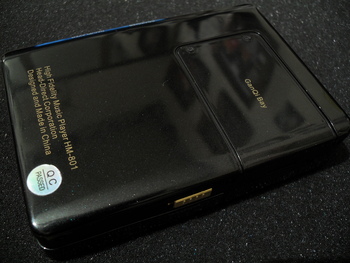
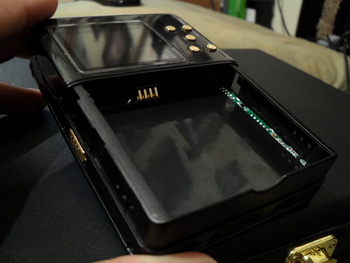


Sound quality
All to the side, because we got to the point. My only headphones for listening to music on this app were Westone ES5 . I have not used any external portable amplifiers. Most of my music is FLAC (about 30%), the rest is in mp3. Portable player I will compare with the 3G iPod Touch.
HiFiMAN HM-801 has a warm, surround sound from which euphoria appears. He wins his iPod in greater liveliness, energy, due to the lack of recession in the mid and high frequencies. There is no limit to detail, audibility extends to the smallest detail. The player produces a real sound, without embellishment and the better the recording will be, the more natural the reproduction. After listening to HiFiMAN HM-801 for a long time , the sound of my iPod seemed dirty, dry and cold, I would never have thought so, but HiFiMAN HM-801 made me do it.
Bass
HiFiMAN HM-801 's bass is bold and strong, there is no excessiveness and you can hear all the bass notes. The bass is wider than that of the iPod, and I did not even think that this was possible with my headphones. The remaining frequencies even after such a bass remain unharmed. The bass is very hard and sharp focus, due to the high output power. It is a little bloated, rather than bright, but nicely presented.
Mid frequencies
These frequencies are more pronounced than all the others. Surprisingly, this does not make the sound too tedious. The vocals, namely the presence of presence is clearly higher than that of the same iPod . You can admire the wide stage and quite often find something new for yourself. Voices sound smoother, brighter and more realistic. The lightness of the guitar, together with other instruments of this range, is also felt passionately.
Low frequency
Gentle, accurate and natural. The iPod, compared to the HiFiMAN HM-801, has a more hazy and lifeless sound. Some people call this sound “digital”, when for some time it is exciting, but later it becomes tiresome. HiFiMAN HM-801 received very few high frequencies, which from the point of view of realism in sound is good, but maybe not what you wanted, because the neutral sound is not the most beautiful from the point of view of musical pleasure. Energy at these frequencies is less than the iPod, but to my great surprise this is enough to show a sound stage that is not in the iPod.
Summarize
HiFiMAN HM-801 will not be the end of the battle for the best portable player of real music gourmets. It has its advantages and disadvantages, which keep it among the leaders in the market of sound sources, like in some other models. For some, this may seem like a gigantic waste of money or a marketing scam. In my opinion, all this is an obvious lie, and if you like music and you have high-quality headphones, feel free to take into account the HiFiMAN HM-801. Its sound is exceptionally excellent, which is confirmed by its legendary iron filling, which is highly regarded in the world of audio professionals, as one of the best DACs ever created. I'm glad I took and bought this device.
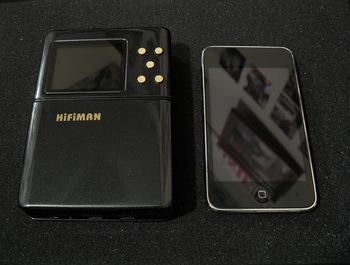
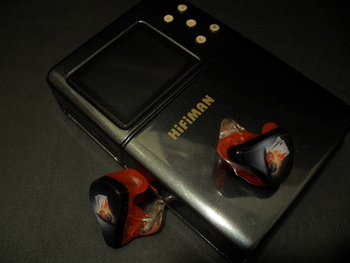
Conclusion
From the translator.
Whatever it was, but the player HiFiMAN HM-801 has no analogues. You can talk a lot about sound, say that Kenwood on hard drives that haven't been released for a long time, or top models from iBasso or Colorful, can serve as an alternative, but it's all one field of berries and the difference in them can be noticed only by a smaller part of those that could notice the difference between Latest iPod and HiFiMAN HM-801. In general, portable amplifiers can be used, but this is the extra weight and unwieldiness of the device, which is often not pleasing to the end user. So the choice is yours.
And finally, the technical characteristics and cost of the device, which is devoted to the article.
Special features
- Bay Modular Amplifier (GanQi Bay) and 14.8 Volt Lithium Polymer Battery;
- Memory Card: SDHC;
- DAC functions: Coaxial (44.1 kHz, 96 kHz), USB-DAC (16 bit, 48 kHz);
- DAC chip: Burr-Brown PCM1704U-K;
- Size: 114 mm 78 mm 25.5 mm;
- Outputs: 3.5mm headphone jack output, line-out;
- Battery operation: from 7 to 8 hours depending on the installed amplifier module;
- Display: LCD (320x240);
- Audio format support: MP3, WMA, OGG, AAC, FLAC, APE, WAV, PCM, ADPCM;
- Body Material: Metal;
Device price: $ 790 .
The originals of all the articles here , here and here .
Source: https://habr.com/ru/post/151957/
All Articles